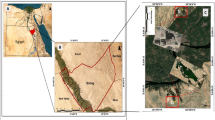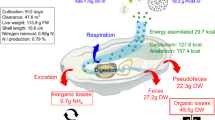Abstract
Bleached kraft mill effluents (BKME) contain both nutrients(nitrogen and phosphorus) and contaminants that can have a stimulatoryor inhibitory effect on riverine food webs. For the Northern RiverBasins Study (NRBS), separation of the effects of nutrients andcontaminants in BKME was an important issue because field biomonitoringwas unable to isolate these impacts. We addressed this problem by usingriverside mesocosm experiments, along with field observations, todetermine the effects of BKME on benthic food webs of the upperAthabasca River near Hinton, Alberta, Canada. Response variablesincluded periphyton biomass, benthic insect density and composition, andthe biomass of abundant invertebrates (i.e., caddisfly, mayfly andstonefly taxa). Experiments were conducted during autumn when nutrientenhancement was hypothesized to increase autochthonous primaryproduction as a result of low river discharge and high water clarity.Treatments included reference river water, 1% BKMEconcentrations, and nutrients (nitrogen plus phosphorus) equivalent tothe 1% BKME treatment. Although pulp mill effluents can inducesublethal toxicity in benthic biota, BKME concentrations equivalent tolevels in the Athabasca River did not cause measurable toxicity.Relative to reference water treatments, BKME-associated increases inavailable phosphorus produced enrichment effects including increases inperiphyton and insect biomass, and invertebrate abundance. Insect familyrichness was not affected by the treatments. The development andapplication of a field-based artificial stream system for the NRBSimproved our mechanistic understanding of the effects of BKME on benthicbiota of nutrient and contaminant stressors. By combining artificialstream results with field observations, we were also able to link thismechanistic understanding of stressor effects directly to impacts in theriver. We conclude that the response to BKME in the Peace-AthabascaBasin is largely one of nutrient enrichment rather than that oftoxicity.
Similar content being viewed by others
References
Anderson, A. M., 1989. An assessment of the effects of the combined pulp mill and municipal effluents at Hinton on the water quality and zoobenthos of the Athabasca River. Report, Environmental Quality Monitoring Branch, Environmental Assessment Division, Alberta Environment, Edmonton, AB, Canada.
Anderson, A. M., 1991. An overview of long-term zoobenthic monitoring in Alberta rivers (1983–1987). Report, Environmental Quality Monitoring Branch, Environmental Assessment Division, Alberta Environment, Edmonton, AB, Canada.
American Public Health Association (APHA), 1995. Standard Methods for the Examination of Water and Wastewater. 19th edition, Washington, D.C., USA.
Bothwell, M. L., 1992. Eutrophication of rivers by nutrients in treated kraft pulp mill effluent. Water Poll. Res. J. Can. 27: 447–472.
Buikema, A. & J. R. Voshell, 1993. Toxicity studies using freshwater benthic macroinvertebrates. In: D. M. Rosenberg & V. H. Resh (eds), Biomonitoring and Benthic Invertebrates, Chapman and Hall, New York, NY, USA, pp. 340–395.
Canadian Council of Minister of the Environment (CCME), 1995. Canadian Environmental Quality Guidelines for Polychlorinated Dibenzo-p-dioxins and Polychlorinated Dibenzofurans. January 1995, CCME Summary Version, Winnipeg, MB, Canada.
Cash, K. J., M. S. J. Ouellette, F. J. Wrona & G. Wagner, 1996. An assessment of the utility of benthic macroinvertebrate and fish community structure in biomonitoring of the Peace, Athabasca and Slave River basins. Report No. 123, Northern River Basins Study, Edmonton, AB, Canada.
Chambers, P. A., 1996. Nutrient enrichment in the Peace, Athabasca and Slave rivers: assessment of present conditions and future trends. Synthesis Report No. 4, Northern River Basins Study, Edmonton, AB, Canada.
Chambers, P. A., A. R. Dale, G. J. Scrimgeour & M. L. Bothwell, 2000. Nutrient enrichment of northern rivers in response to pulp mill and municipal discharges. J. Aquat. Ecosystem Stress and Recovery 8: 53–66.
Culp, J. M. & C. L. Podemski, 1996a. Impacts of contaminants and nutrients in bleached kraft mill effluent on benthic insect and periphyton communities: assessments using artificial streams, Athabasca River 1993 and 1994. Report No. 92, Northern River Basins Study, Edmonton, AB, Canada.
Culp, J. M. & C. L. Podemski, 1996b. Design and application of a novel stream microcosm system for assessing effluent impacts to large rivers. In: M. R. Servos, K. R. Munkittrick, J. H. Carey & G. J. Van Der Kraak (eds), Environmental Fate and Effects Of Pulp and Paper Mill Effluents, St. Lucie Press, Boca Raton, FL, USA, pp. 549–555.
Culp, J. M., C. L. Podemski, K. J. Cash & R. B. Lowell, 1996. Utility of field-based artificial streams for assessing effluent effects on riverine ecosystems. J. Aquat. Ecosystem Health 5: 117–124.
Culp, J. M., R. B. Lowell & K. J. Cash, 2000a. Integrating in situ community experiments with field studies to generate weight-of-evidence risk assessments for large rivers. Environ. Toxicol. Chem. 19: 1167–1173.
Culp, J. M., K. J. Cash & F. J. Wrona, 2000b. Cumulative effects assessment for the Northern River Basins Study. J. Aquat. Ecosystem Stress and Recovery 8: 87–94.
Day, K. & T. B. Reynoldson. 1995. Ecotoxicology of depositional sediments, Athabasca River, May to September 1993. Report No. 59, Northern Rivers Basin Study, Edmonton, AB, Canada.
Dobson, E., K. Day & T. B. Reynoldson. 1996. Ecotoxicology of suspended and bottom sediments, Athabasca, Smoky and Peace Rivers, June 1995. Report No. 135, Northern Rivers Basin Study, Edmonton, AB, Canada.
Dubé, M. G. & J. M. Culp, 1996. Growth responses of periphyton and chironomids exposed to biologically treated bleached-kraft pulp mill effluent. Environ. Toxicol. Chem. 15: 2019–2027.
Environment Canada, 1994. Hydat CD ROM Version 3.0 Surface Water Data. Environment Canada, Water Survey of Canada, Ottawa, ON, Canada.
Feder, H. M. & T. H. Pearson, 1988. The benthic ecology of Loch Linnhe and Loch Eil, a sea-loch system on the west coast of Scotland: V. Biology of the dominant soft-bottom epifauna and their interaction with the infauna. J. Exp. Mar. Biol. Ecol. 116: 99–134.
Forbes, V. E. & T. L. Forbes, 1994. Ecotoxicology in Theory and Practice. Chapman and Hall, New York, NY, USA, 247 pp.
Gibbons, W. N., K. R. Munkittrick & W. D. Taylor, 1998. Monitoring aquatic environments receiving industrial effluents using small fish species 1: response of spoonhead sculpin (Cottus ricei) downstream of a bleached-kraft pulp mill. Environ. Toxicol. Chem. 17: 2227–2237.
Golder Associates, 1994. Environmental Effects Monitoring Predesign Study Report for Weldwood of Canada, Ltd. Hinton, AB, Canada.
Gummer, Wm. D., K. J. Cash, F. J. Wrona & T. D. Prowse, 2000. The Northern River Basins Study: context and design. J. Aquat. Ecosystem Stress and Recovery 8: 7–16.
Hall, T. J., R. K. Haley & L. E. LaFleur, 1991. Effects of biologically treated bleached kraft mill effluent on cold water stream productivity in experimental stream channels. Environ. Toxicol. Chem. 10: 1051–1060.
Hansson, S., 1987. Effects of pulp and paper mill effluents on coastal fish communities in the Gulf of Bothnia, Baltic Sea. Ambio 16: 344–348.
Lamberti, G. A & A. D. Steinman, 1993. Research in artificial streams: Applications, uses, and abuses. J. North Amer. Benthol. Soc. 12: 313–384.
Lowell, R. B., J. M. Culp & F. J. Wrona, 1995. Stimulation of increased short-term growth and development of mayflies by pulp mill effluent. Environ. Toxicol. Chem. 14: 1529–1541.
Lowell, R. B., J. M. Culp & M. G. Dubé, 2000. A weight of evidence approach for northern river risk assessment: integrating the effects of multiple stressors. Environ. Toxicol. Chem. 19: 1182–1190.
Lozano, R. B. & J. R. Pratt, 1994. Interaction of toxicants and communities: the role of nutrients. Environ. Toxicol. Chem. 13: 361–368.
McCubbin, N. & J. Folke, 1993. A review of literature on pulp and paper mill effluent characteristics in the Peace and Athabasca River basins. Report No. 15, Northern River Basin Study, Edmonton, AB, Canada.
McLeay, D. J., 1987. Aquatic toxicity of pulp and paper mill effluent: a review. Report No. EPS 4/PF/1, Environmental Protection Series, Conservation and Protection, Environment Canada, Ottawa, ON, Canada.
Merritt, R. W. & K. W. Cummins, 1996. Aquatic Insects of North America, Kendall/Hunt Publishing Company, Dubuque, IA, USA, 862 pp.
Mohamed, M. N., J. R. Lawrence & R. D. Robarts, 1998. Phosphorus limitation of heterotrophic biofilms from the Fraser River, British Columbia, and the effect of pulp mill effluent. Microb. Ecol. 36: 121–130.
Owens, J. W., 1991. The hazard assessment of pulp and paper effluents in the aquatic environment: a review. Environ. Toxicol. Chem. 10: 1511–1540.
Pastershank, G. M. & D. G. C. Muir, 1995. Contaminants in environmental samples: PCDDs and PCDFs downstream of bleached kraft mills, Peace and Athabasca Rivers, 1992. Report No. 44, Northern River Basins Study, Edmonton, AB, Canada.
Podemski, C. L., 1999. Ecological effects of a bleached kraft pulp mill effluent on benthic biota of the Athabasca River. Ph.D. Thesis. Univ. Saskatchewan, 292 pp.
Podemski, C. L. & J. M. Culp, 1996. Nutrient and contaminant effects of bleached kraft mill effluent on benthic algae and insects of the Athabasca River, AB, Canada. In: M. R. Servos, K. R. Munkittrick, J. H. Carey & G. J. Van Der Kraak (eds), Environmental Fate and Effects of Pulp and Paper Mill Effluents, St. Lucie Press, Boca Raton, FL, USA, pp. 571–580.
Rosenberg, D. M. & V. H. Resh, 1993. Biomonitoring and benthic invertebrates, Chapman and Hall, New York, NY, USA, 488 pp.
Rosenthal, G. A. & D. H. Janzen. 1979. Herbivores: their Interaction with Wecondary Plant Metabolites, Academic Press Inc., New York, NY, USA, 718 pp.
Scrimgeour, G. J., J. M. Culp & N. E. Glozier, 1993. A new technique for sampling lotic invertebrates. Hydrobiologia 254: 65–71.
Scrimgeour, G. J., P. A. Chambers, J. M. Culp & C. L. Podemski, 1995. Identification of spatial and temporal patterns in nutrient limitation Athabasca River, October to December 1993. Report No. 49, Northern River Basins Study, Edmonton, AB, Canada.
Scrimgeour, G. J. & P. A. Chambers, 2000. Cumulative effects of pulp mill and municipal effluents on epilithic biomass and nutrient limitation in a large northern river ecosystem. Can. J. Fish. Aquat. Sci. 57: 1342–1354.
Stewart, K. W. & B. P. Stark, 1993. Nymphs of North American Stonefly Genera (Plecoptera), University of North Texas Press, Denton, TX, 460 pp.
Swanson, S. M., R. Schryer, R. Shelast, P. Kloepper-Sams & J. W. Owens, 1994. Exposure of fish to biologically treated bleached-kraft mill effluent. 3. Fish habitat and population assessment. Environ. Toxicol. Chem. 13: 1497–1507.
TAEM, 1993. Biological and water quality survey of the Athabasca River, October 1992. Report, Weldwood of Canada Ltd., Hinton, AB, Canada.
Walden, C. C. & T. E. Howard, 1977. Toxicity of pulp and paper mill effluents: a review of regulation and research. TAPPI 60: 122–125.
Wassenaar, L. I. & J. M. Culp, 1996. The use of stable isotopic analyses to identify pulp mill effluent signatures in riverine food webs. In: M. R. Servos, K. R. Munkittrick, J. H. Carey & G. J. Van Der Kraak (eds), Environmental Fate and Effects of Pulp and Paper Mill Effluents, St. Lucie Press, Delray Beach, FL, USA, pp. 413–423.
Wrona, F. J. & K. J. Cash, 1996. The ecosystem approach to environmental assessment: moving from theory to practice. J. Aquat. Ecosystem Health 5: 79–87.
Author information
Authors and Affiliations
Corresponding author
Rights and permissions
About this article
Cite this article
Culp, J.M., Podemski, C.L. & Cash, K.J. Interactive effects of nutrients and contaminants from pulp mill effluents on riverine benthos. Journal of Aquatic Ecosystem Stress and Recovery 8, 67–75 (2000). https://doi.org/10.1023/A:1011452108483
Issue Date:
DOI: https://doi.org/10.1023/A:1011452108483




